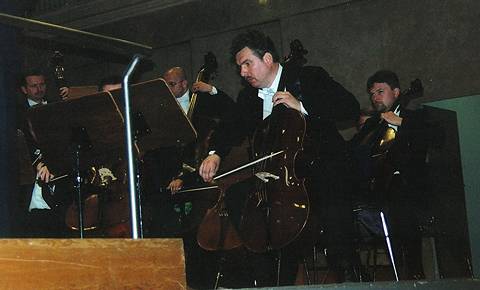|
<< -- 3 -- Tess Crebbin EUROPAMUSICALE POLAND

The piece has an extremely haunting ending, an epilogue that reflects the prologue of alternating canons,
consisting of a twelve tone row and based exclusively on minor seconds and tritones. In the epilogue, which
starts as fortissimo, the canons reappear. The solo cello's call is being answered by the violins,
with the cello calling out to them and the violins echoing the call until they echo no more and the cello is
left behind alone. The celebrated young pianist Lang Lang said: 'Every musical piece tells you a story,
sometimes it is a really sad story, you only have to know, as a performer, how to listen to it and call it
forth from your instrument.' As the title suggests, Lutoslaswki's piece tells a very sad story, it was written
in memory of Béla Bartók, but it takes a world-class cellist, or at least a world-class cellist
in the making, to bring this story to life. Wyroba is able to rise to the occasion. For him, the cello is not
just an instrument but an entity he forms a partnership with. To tell a story hidden in a music piece,
he calls the notes forth from his instrument as a father would coax his best performance out of his son: with
immense sensitivity on an interpretative and musical level and great skill on the tonal and technical front.
'I play as soloist in my own country', Wyroba said about his training, 'and I think I have benefited a lot
from observing some of the great people I have had the good fortune to work with. Who I have learned from the
most, I think, also in terms of the very personal relationship that a musician needs to build with his instrument,
is the recently deceased Boris Pergamenschikow. I studied cello at the conservatories in Krakow and Warsaw, but
he is the one who was my greatest inspiration. I had the good luck to play with him and since he was also one
of the foremost cello teachers in the world, you learn an awful lot from someone like him.'

Tomasz Wyroba (foreground) and members of the cello and bass sections of Sinfonietta Cracovia. Photo © Bettina Pauli
|
The result of Wyroba's encounter with Russian-born Pergamenschikow is a young cellist who tells the story
so well that it draws you into what is happening in the orchestra on stage, whether you have your eyes closed
or open, whether your thoughts have just drifted off a moment earlier or not. Wyroba at the cello commands
attention and he gets it. In the case of Lutoslawski, it was a truly dramatic experience, but it was an
experience not to be missed. The forlorn call of the cello to the increasingly silent violins can only be
correctly played by a performer to whom his instrument is a mere extension of his own self, like
Pergamenschikow stated in one of his final interviews it should be. With the new expansion of the European
Union and the opportunities that now result for the musicians of these countries, the world is sure to hear
more of this tall (somewhere around six foot two) musician for Wyroba appears to be a world-class cellist in
the making.
Penderecki's own music was also well received, with standing ovations at the end and two encores. Audiences
were thrilled to hear the maestro conduct his own work. 'I started out as a violinist, and I love virtuoso
pieces, especially string pieces', Penderecki said. 'To me, a conductor and a composer should not be separated,
as they are now. You can only compose if you understand how to conduct and vice versa.'
Continue >>
Copyright © 27 May 2004
Tess Crebbin, Germany

|

